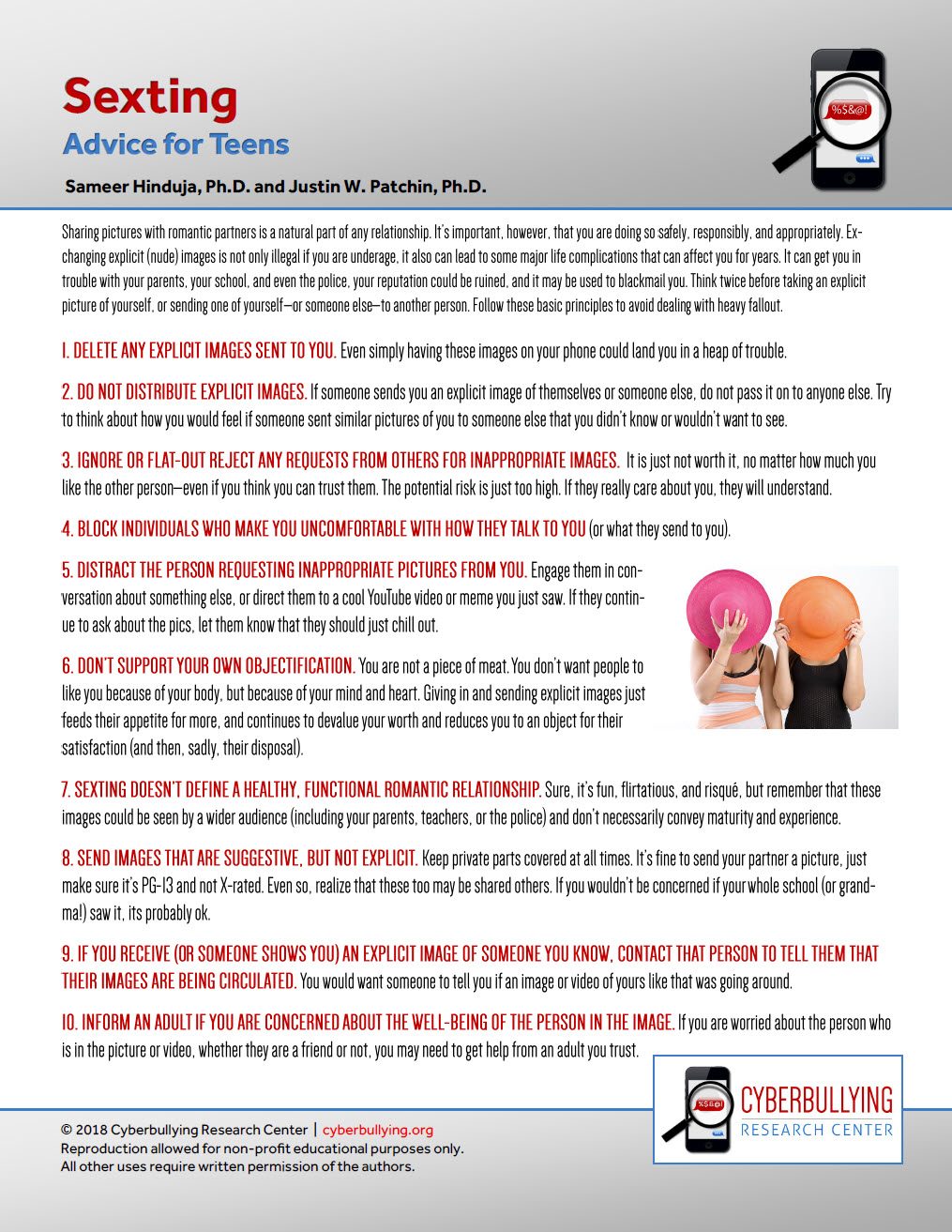
(For a formatted .pdf version of this article for distribution, click here]).
Spanish Translation Available Here
Sharing pictures with romantic partners is a natural part of any relationship. It’s important, however, that you are doing so safely, responsibly, and appropriately. Exchanging explicit (nude) images is not only illegal if you are underage, it also can lead to some major life complications that can affect you for years. It can get you in trouble with your parents, your school, and even the police, your reputation could be ruined, and it may be used to blackmail you. Think twice before taking an explicit picture of yourself, or sending one of yourself—or someone else—to another person. Follow these basic principles to avoid dealing with heavy fallout.
1. DELETE ANY EXPLICIT IMAGES SENT TO YOU. Even simply having these images on your phone could land you in a heap of trouble.
2. DO NOT DISTRIBUTE EXPLICIT IMAGES. If someone sends you an explicit image of themselves or someone else, do not pass it on to anyone else. Try to think about how you would feel if someone sent similar pictures of you to someone else that you didn’t know or wouldn’t want to see.
3. IGNORE OR FLAT-OUT REJECT ANY REQUESTS FROM OTHERS FOR INAPPROPRIATE IMAGES. It is just not worth it, no matter how much you like the other person—even if you think you can trust them. The potential risk is just too high. If they really care about you, they will understand.
4. BLOCK INDIVIDUALS WHO MAKE YOU UNCOMFORTABLE WITH HOW THEY TALK TO YOU (or what they send to you).
5. DISTRACT THE PERSON REQUESTING INAPPROPRIATE PICTURES FROM YOU. Engage them in conversation about something else, or direct them to a cool YouTube video or meme you just saw. If they continue to ask about the pics, let them know that they should just chill out.
6. DON’T SUPPORT YOUR OWN OBJECTIFICATION. You are not a piece of meat. You don’t want people to like you because of your body, but because of your mind and heart. Giving in and sending explicit images just feeds their appetite for more, and continues to devalue your worth and reduces you to an object for their satisfaction (and then, sadly, their disposal).
7. SEXTING DOESN’T DEFINE A HEALTHY, FUNCTIONAL ROMANTIC RELATIONSHIP. Sure, it’s fun, flirtatious, and risqué, but remember that these images could be seen by a wider audience (including your parents, teachers, or the police) and don’t necessarily convey maturity and experience.
8. SEND IMAGES THAT ARE SUGGESTIVE, BUT NOT EXPLICIT. Keep private parts covered at all times. It’s fine to send your partner a picture, just make sure it’s PG-13 and not X-rated. Even so, realize that these too may be shared others. If you wouldn’t be concerned if your whole school (or grandma!) saw it, its probably ok.
9. IF YOU RECEIVE (OR SOMEONE SHOWS YOU) AN EXPLICIT IMAGE OF SOMEONE YOU KNOW, CONTACT THAT PERSON TO TELL THEM THAT THEIR IMAGES ARE BEING CIRCULATED. You would want someone to tell you if an image or video of yours like that was going around.
10. INFORM AN ADULT IF YOU ARE CONCERNED ABOUT THE WELL-BEING OF THE PERSON IN THE IMAGE. If you are worried about the person who is in the picture or video, whether they are a friend or not, you may need to get help from an adult you trust.
Citation information: Hinduja, S. & Patchin, J.W. (2018). Sexting: Advice for teens. Cyberbullying Research Center. Retrieved [insert date], from https://cyberbullying.org/sexting-advice-teens.pdf
Keywords: sexting, teens, tips, prevention, explicit images, nudes








What I like about this article is it doesn't encourage teens to make sexting a habit, but on how to avoid to be a victim of anonymous texts.
This article to me, is similar to how students are taught safe sex in high school. They are taught abstinence but ultimately, teachers know that students will do what they want regardless of advice. Which leads, to actual safe sex lessons, including condoms and routine check up for STD screenings. So this article is saying that students shouldn't share nude photos of themselves, but if you do choose to show them, make sure you cover a specific part.
This is on point, Jordan. Research has shown that safe sex education was useful and led to healthier outcomes among youth. It's arguable that since kids are going to sext, we should be teaching safe sext education at least to high schoolers – in some capacity. It's not a black-and-white answer and there are many issues and complications to consider, but I hope to blog about it in detail soon.